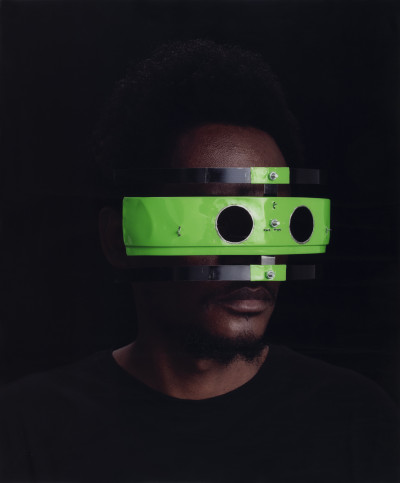
March 10, 2022 - April 30, 2022
Unisa Art Gallery
The curatorial concept for this exhibition is informed by three fundamental ideas: blindness, visibility, and blackness as interpreted from the selected contemporary African artists on show. Philosophically, Molyneux’s problem is based on the thought experiment that was proposed by the philosopher William Molyneux. Molyneux had lodged an enquiry in the seventeenth century that if a person, blind from birth, who could tell apart a cube and a sphere by touch: if his vision were restored and he was presented with the same cube and sphere, would he be able to tell which was which by sight alone?
The response to this question divided philosophers into two epistemic positions of thought: rationalism and empiricism. Both these schools of thought are concerned with how humans gain knowledge. Rationalism is linked to positivism, realism, and reasoning, and thus for the rationalists, knowledge is acquired through intuition and our ability to reason. While empiricism on the other side, is linked to experimentation, senses, and experience, and thus for empiricists knowledge is gained through learning and experience.
So, in Molyneux’s problem, the rationalists argued that a person seeing for the first time would be able to recognise and differentiate the cube from a sphere. While the empiricists on the contrary advanced that a person would not be able to tell which one is the cube from a sphere. It is critical to note that the rationalists viewed gaining knowledge as innate and based on unchanging dimensions of knowing and being. While the empiricists recognised that our experiences help teach our visual systems how to learn and interpret our assumed or imagined realities, thus presenting an opportunity for lifting our curtain of blindness. Understanding this logic changes the concept of lifting the curtain to blindness beyond its metaphorical state. The concept then ushers an active and continuous process based on admitting our blind spots in acts of seeing colour and hidden disparities. It becomes an acknowledgment and legitimisation of the lived experiences of those around us, especially of those from the state of blackness.
The exhibition proposes a new line of thought where seeing the state of blackness is extended further to restore the full humanity of the subjugated, less-privileged cultures, the LGBTQQIP2SAA society, the poor and the less-abled bodies, the insignificant others, and those that Frantz Fanon (1963) referred to as the Wretched of the Earth. It is argued that the notion of blackness emerged from black existential philosophy. As informed by the main existential line of thought, blackness is a branch of Africana philosophy and black philosophical thought.
While black philosophical thought pertains to the ideas emerging from black-designated peoples, blackness is however in the concept of the exhibition - an experience and a state of mind. CURATORIAL CONCEPT DR. BONGANI MKHONZA (FEBRUARY 25, 2022) . Blackness is socially constructed so only the same society can deconstruct it. In South Africa, the ideas of blackness and black consciousness are linked to Steven Bantu Biko, Mabogo More, Tendai Sithole, Andile Mngxitama and other emerging scholars. The metaphor of the invisible blackness in the context of this exhibition is inspired by Ralph Waldo Ellison who was an American African novelist, literary critic, and scholar best known for his novel Invisible Man (1952). Contemporary black writers such as Toni Morison, James Baldwin, Ta-Nehisi Coates, and many others have advanced Ellison's ideas in our recent history. These authors reveal that Blackness remains one of the invisible fields of existence around the world. The pursuit of lifting the curtain can be referred to as what W.E.B du Bois (1961) called Lifting the Veil of Race.
More reflectively, it can be imagined as an existential undertaking for people to learn and experience how it is like ‘to see’ beyond their preconceived realities. The selected artworks in the exhibition touch on a vast number of discourses that lifts its gaze beyond the problem of the colour line’ as expressed by WEB du Bois (1961). Manifested in art and different visual languages, the exhibition is an invitation to question our complicity and how our daily practices are implicated in sustaining the silencing of voices, being blinded from the lived experiences, and muting of the dialogues, especially around the issues of invisibility, blindness, and blackness.
In line with a curatorial concept, some of the selected artists on show are as follows:
Usha Seejarim; Jeannette Ehlers; Tuli Mekondjo; Letso Leipego; Cyrus Kabiru;
Mohau Modisakeng; Ayanda Mabulu; Nandipha Mntambo; Nandipha Mntambo;
Lizette Chirrime; Ayana V. Jackson; Kudzanai Chiurai; Mary Sibande; Philemon
Hlungwani; and many more artists.





























